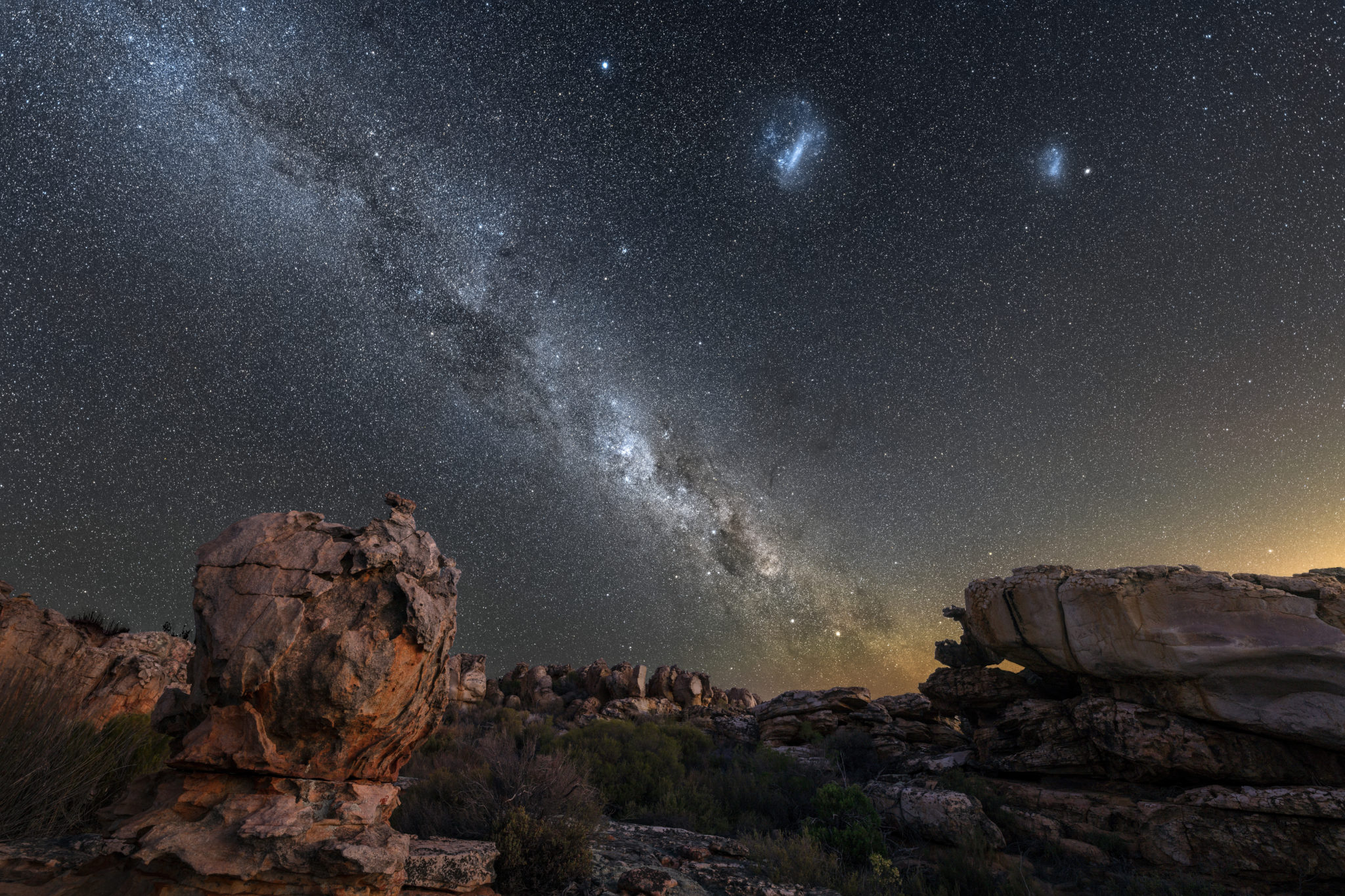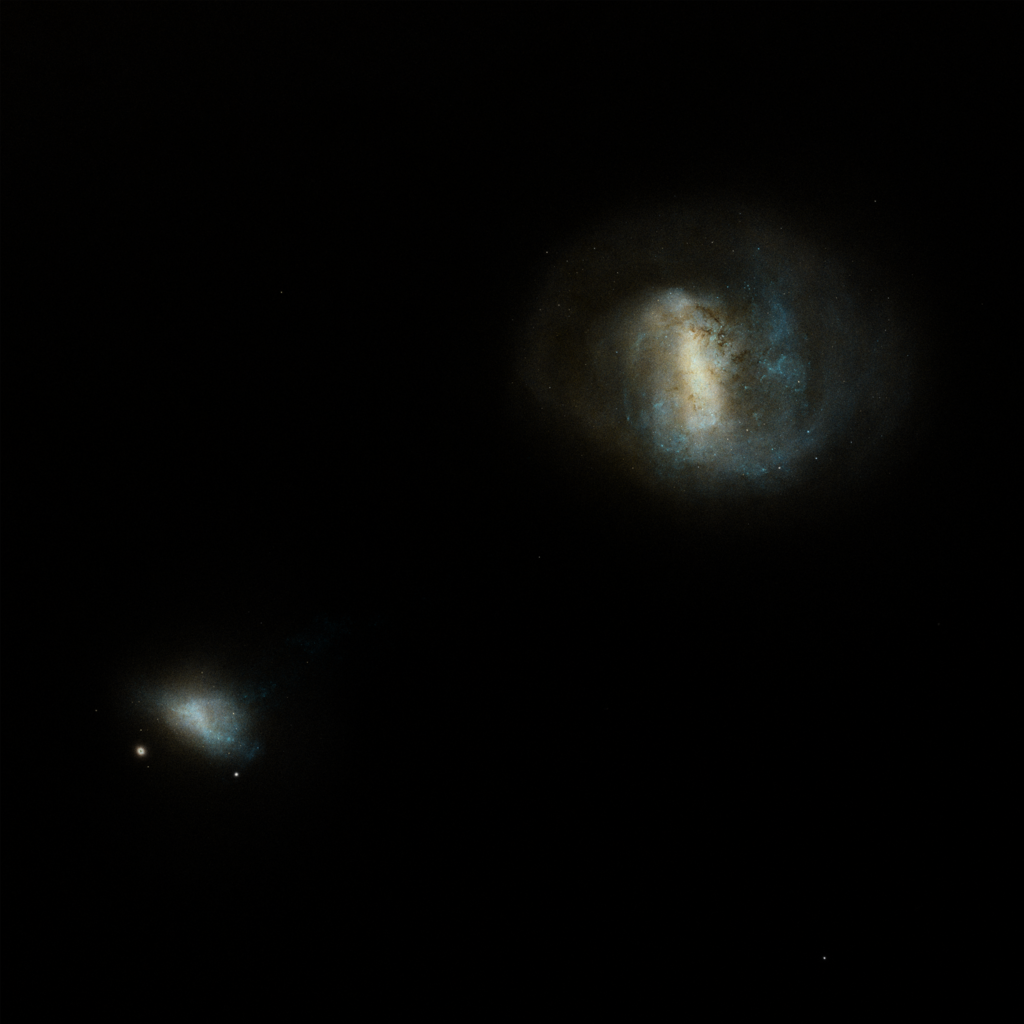Direct Evidence for Magellanic Clouds’ Designs
Who thinks about vast galaxies and how their movements might affect humanity? Probably not many of us, but astronomers study galaxy movements in order to learn as much as they can about the universe. Some of their recent discoveries have helped answer questions while revealing design.
The Magellanic Clouds are the nearest galaxies visible to the naked eye (see figure 1). The Large Magellanic Cloud (LMC) is the third-largest galaxy by mass in the Local Group, following the Andromeda Galaxy and the Milky Way Galaxy (MWG). The Small Magellanic Cloud (SMC) is the sixth-largest galaxy in the Local Group.
Figure 1: Large and Small Magellanic Clouds. Foreground stars have been removed from the image.
Image credit: Kevinmloch, Creative Commons Attribution
In previous articles1 I describe how the design of the Magellanic Clouds allows them to funnel just-right streams of gas, dust, and small dwarf galaxies into the MWG’s core. It is thanks to these just-right streams that the MWG’s spiral arms possess the structure, symmetry, and stability needed for advanced life.
For the funnel induced by the Magellanic Clouds to adequately sustain the MWG’s spiral structure, the LMC’s total mass must be at least 200 billion solar masses. Astronomers’ measurements of the LMC’s total mass place it between 200 and 300 billion solar masses.2 The total mass of the Small Magellanic Cloud (SMC) measures about 14 billion solar masses. Based on mass levels and proximity to the MWG (163 and 175 million light-years respectively), astronomers have calculated that gravitational interactions between the Magellanic Clouds and the MWG should already be starting to give rise to disequilibrium phenomena in the outer part of the MWG.3
Astronomical observations show that the LMC is speeding toward the MWG at a velocity of about 20 kilometers per second (45,000 miles per hour).4 Therefore, it is only a matter of time before that part of the MWG where the solar system resides becomes gravitationally destabilized.
These calculations raise questions pertinent to human civilization and to philosophy. First, to what degree has life on Earth been impacted by the approach of the LMC? Second, how soon will the LMC’s approach bring an end to human life? Third, thinking philosophically, to what degree do the characteristic features of the Magellanic Clouds provide evidence that they have been designed for the specific benefit of humanity?
Galactic Halo Map
In an endeavor to answer the first two questions, a team of seven astronomers, led by Charlie Conroy at Harvard University’s Center for Astrophysics, analyzed recent high-precision measurements of the distances, positions, and velocities of 1,301 stars at distances from the MWG’s center ranging from 60 to 100 kiloparsecs (196,000 to 326,000 light-years).5 This sample did not include any stars associated with the LMC, the SMC, the Sagittarius Stream, or MWG disk stars.
Several other research teams had previously performed computer simulations of the gravitational interactions between the LMC and the MWG’s stellar and dark matter halo.6 Conroy and his colleagues added four more computer simulations for a range of LMC masses. These simulations predicted that a local wake of matter would trail the orbit of the LMC around the MWG. They also predicted the existence of a large-scale overdensity across a large part of the northern galactic hemisphere (celestial sky north of the MWG’s disk). However, astronomers had been stymied in their efforts to definitively detect either the predicted wake or the overdensity.
Conroy’s team’s analysis of the 1,301 stars clearly revealed a wake trailing behind the LMC. They also detected the predicted northern overdensity. The wake was strong enough to eliminate the possibility that the LMC and SMC were on their second orbit around the MWG. If the LMC and SMC had undergone more than one complete orbit, then the wake would be much weaker, likely not even detectable.
Galactic Halo Map Implications
Conroy’s team noted a striking agreement between the observations and computer simulations. They also showed that more precise measurements of the location of the wake trailing the LMC will provide stronger constraints on the masses of the MWG and LMC and on the LMC’s orbit.
Already, the agreement affirmed that the LMC’s total mass is indeed greater than 200 billion solar masses and likely close to 300 billion solar masses. The orbit of the LMC and SMC about the MWG is decaying. The Magellanic Clouds are on a collision trajectory with our MWG.
The collision is not imminent. It will take another 2.5 billion years for the LMC and SMC to merge with the MWG. The merger will increase the mass of the MWG’s central supermassive black hole from its present minuscule 4 million solar masses7 to as much as 32 million solar masses8 and shower the entirety of the MWG with deadly radiation. The merger also will eject an enormous number of the MWG’s disk stars to the MWG’s halo. It is unlikely that the solar system’s orbit about the MWG’s core will remain undisturbed.
Obviously, the future does not bode well for advanced life in the solar system. However, neither did the past. It is the present that is an amazing marvel.
It took the approach of the LMC and the SMC toward the MWG and the precise characteristics of the LMC and the SMC to endow our MWG with the just-right spiral arm structure at the just-right time so that advanced life could exist and thrive at the just-right location within the MWG. Thanks to the just-right configurations and dynamics of the LMC, SMC, and MWG a temporary home for humanity is possible in the universe. As the opening stanza of a famous gospel hymn declares, “This world is not my home. I’m just a passing through. My treasures are laid up somewhere beyond the blue.”
Endnotes
- Hugh Ross, “It Pays for a Galaxy to Slowly Sip, Not Gulp,” Today’s New Reason to Believe (blog), May 18, 2020; Hugh Ross, “Your Galaxy’s Diet Is Important for Your Health,” Today’s New Reason to Believe (blog), September 7, 2015.
- Marius Cautun et al., “The Aftermath of the Great Collision between Our Galaxy and the Large Magellanic Cloud,” Monthly Notices of the Royal Astronomical Society 483, no. 2 (February 2019): 2185–2196, doi:10.1093/mnras/sty3084; Jorge Peñarrubia et al., “A Timing Constraint on the (Total) Mass of the Large Magellanic Cloud,” Monthly Notices of the Royal Astronomical Society: Letters 456, no. 1 (February 2016): L54–L58, doi:10.1093/mnrasl/slv160; Chervin F. P. Laporte et al., “Response of the Milky Way’s Disc to the Large Magellanic Cloud in a First Infall Scenario,” Monthly Notices of the Royal Astronomical Society 473, no. 1 (January 2018): 1218–1230, doi:10.1093/mnras/stx2146; A. J. Deason et al., “Satellites of LMC-Mass Dwarfs: Close Friendships Ruined by Milky Way Mass Haloes,” Monthly Notices of the Royal Astronomical Society 453, no. 4 (November 2015): 3568–3574, doi:10.1093/mnras/stv1939.
- Laporte et al., “Response of the Milky Way’s Disc,” 1218–1230; Nicolas Garavito-Camargo et al., “Hunting for the Dark Matter Wake Induced by the Large Magellanic Cloud,” Astrophysical Journal 884, no. 1 (October 10, 2019): id. 51, doi:10.3847/1538-4357/ab32eb; Michael S. Petersen and Jorge Peñarrubia, “Reflex Motion in the Milky Way Stellar Halo Resulting from the Large Magellanic Cloud Infall,” Monthly Notices of the Royal Astronomical Society: Letters 494, no. 1 (May 2020): L11–L16, doi:10.1093/mnras/slaa029.
- Cautun et al., “Aftermath of the Great Collision,” 2185–2196.
- Charlie Conroy et al., “All-Sky Dynamical Response of the Galactic Halo to the Large Magellanic Cloud,” Nature 592, no. 7855 (April 22, 2021): 534–536, doi:10. 1038/s41586-021-03385-7.
- Emily C. Cunningham et al., “Quantifying the Stellar Halo’s Response to the LMC’s Infall with Spherical Harmonics,” Astrophysical Journal 898, no. 1 (July 20, 2020): id. 4, doi:10.3847/1538-4357/ab9b88; Laporte et al., “Response of the Milky Way’s Disc,” 1218–1230; Garavito-Camargo et al., “Hunting for the Dark Matter Wake,” id. 51; Petersen and Peñarrubia, “Reflex Motion in the Milky Way Stellar Halo,” L11–L16.
- A. Boehle et al., “An Improved Distance and Mass Estimate for SGR A* from a Multistar Orbit Analysis,” Astrophysical Journal 830, no. 1 (October 10, 2016): id. 17, doi:10.3847/0004-637X/830/1/17.
- Cautun et al., “Aftermath of the Great Collision,” 2185–2196.







